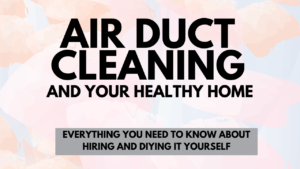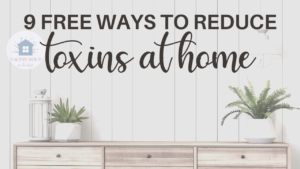
Carpet has been added to homes for YEARS – and in many cases, it was added right over beautiful hardwood floors to give the home a more comfortable feel. It was a sign of a warm and inviting home. As we break down non toxic carpet in this post, you’ll see it is anything but inviting for your health.
The dissppointing news is that most carpets you find are synthetic, coated with toxins and wreaking havoc on your indoor air quality. But the GOOD news is that there are non toxic carpet options that are readily available for you to add to your space without bringing in toxins.
And you know the trick, you just have to know WHAT to look for. Because even if you can’t bring in a totally non toxic carpet, there are options for low toxin carpets that will at least be somewhat healthier to your home.
I get it, some rooms just need that soft and inviting feel of carpet beneath your feet. You don’t have to give up coziness for the sake of health. You can definitely have both.
Why Conventional Carpet is a Major Indoor Pollutant
Most carpets are made with synthetic fibers like nylon and polyester, which are derived from petroleum-based products. While they may seem soft and durable, these materials contain a cocktail of chemicals that continue to off-gas long after installation. Some of the most concerning chemicals found in conventional carpet include:
Formaldehyde: We know that formaldehyde is a known carcinogen, and that it never stops off-gassing. We also know that our homes oftentimes have formaldehyde in many of the building materials present. Formaldehyde in carpet is usually in older carpets, but it is present in some newer carpets too. Formaldehyde can cause skin irritation, increased risk of cancer, bronchitis neurological effects. (STUDY)
Formaldehyde is used as a preservative and is present in the adhesives used to attach the carpeting to the subfloor and padding.
Xylene: Xylene is a type of solvent that is often found in adhesives used to attach the carpet to the padding and subfloor. It can also be found in the fibers of the carpet itself, which can be made of a polyester blend.
Xylene is absorbed by the body through skin and inhalation. What Xylene does within our bodies is it creates an imbalance between the production of free radicals and the body’s ability to detoxify their harmful effect. Basically it burdens our body and does not allow natural detoxification of our hormones and neurotransmitters. (Research)
Benzene: Benzene is used in the making of carpet fibers, especially nylon carpet fibers. It can also be found in SBR-latex-backed carpets. Benzene is a VOC, which means it off-gasses for the lifetime of the carpet. It is also found in the adhesive used to attach the carpet to the subfloor or padding.
Benzene is a known carcinogen to humans and chronic exposure to benzene can reduce the production of both red and white blood cells from humans, resulting in anemia. (Research)

Toluene: Toluene is also a VOC, which again, means it is off-gassing constantly. Toluene is used in the adhesives that are used during installation of carpet.
Chronic exposure to Toluene has lasting effects to humans. It’s not only a known carcinogen, but it also damages the liver and kidneys, which our bodies use every day to detox our systems. Toluene can also worsen the symptoms of asthma and cause headaches in some individuals. (Information)
Styrene: Styrene is a petroleum by-product used to make the backing on many carpets, particularly vinyl backed carpet tiles.
Styrene has a number of problematic side effects including an increased risk of cancer (particularly Leukemia in children and lymphoma). It also causes damage to the liver, kidneys, spleen and nervous system. Short term side effects include vision impairments and respiratory irritation. (Resources)
PFCs: PFCs or Perfluorinated Compounds have been replacing PFOS and PFOA, which are very toxic in many products, including carpet. PFCs are used to create a stain barrier and water resistant barrier on many carpet products. You can find carpets that don’t use this, but often it’s added during manufacturing.
This chemical is toxic to the immune function, especially in children. It has a possible correlation with cancer in humans, and causes damage to the neurological system. (Resource)
Flame Retardants: Flame retardants are often found in the padding underneath carpet, and specifically, polyurethane carpet cushion. It is likely more of a present problem in older carpet, however it is still added to modern synthetic carpet.
The list of health effects from flame retardants include disruption to the endocrine system, higher risk of cancer, hyperactivity, reduced IQ and reduced fertility.

Best Non-Toxic Carpet Materials
If you love the warmth and comfort of carpet but want to avoid toxins, there are several safe and sustainable alternatives to consider:
Natural Wool: Natural wool is an excellent option for non toxic carpet, and probably has the most options in terms of colors and textures. Wool carpet doesn’t show dirt and daily wear quite as much as synthetic carpet. It keeps its shape very well and doesn’t get matted down easily.
Wool can also be a good insulator for homes with concrete slab floors. Another bonus is that wool is naturally fire resistant. You will want to be cautious, however, as most wool absorbs water and moisture instead of repelling it.
Jute, Seagrass or Sisal: These are all natural non toxic carpet fibers with natural weaves oftentimes. These fibers are biodegradable and are often quite inexpensive. Jute, Sisal or Seagrass tend to mask dirt as they have neutral shades. They are oftentimes a very low pile carpet, and so they tend not to show wear as much as high pile non toxic carpet.
One thing to keep in mind about jute, seagrass or sisal is that they don’t respond well to water or humidity as they are a very natural fiber.
Hemp: Hemp is another low pile option for non toxic carpet. It has a very organic look and feel to it and is highly durable. It’s actually a fairly water resistant and mildew resistant material and has antibacterial properties as well.
Try to find a carpet that has either natural dyes or is left undyed, as this can sometimes introduce toxins to your home. Also, hemp is not an extremely soft material, and so often it is blended with another material such as cotton to obtain a more luxurious feel.
Cotton: Of course cotton makes the list of non toxic carpet materials. If you can find a cotton that is grown without pesticides, even better. Cotton is very strong and durable when it comes to carpet fibers. It’s often added to rougher textures and fibers in order to give it a softer feel. Another reason it is added and blended with other fibers is so that it can hold dyes and colors.
Cotton carpet on it’s own can be problematic if it gets wet, as it has a very hard time drying out. Another disadvantage of cotton carpeting is that it is flammable, however, if blended with another material, this could be less of a concern.
Natural Felt Carpet Padding: Instead of using a standard underlayment for non toxic carpet, opt for an all natural felt pad underlayment. It not only is non toxic, but it also has excellent thermal and acoustic insulation for homes. It’s a very soft and cushy padding that often prolongs the life of carpet itself. It also is really good for thermal insulation, which can cut down on heating bills.

NON TOXIC CARPET OPTIONS
Nature’s Carpet: Made of 100% wool with a natural jute backing, it’s perfect for residential heavy traffic areas. They offer a medium pile, for a great comparison to regular synthetic carpet in terms of feel and appearance.
Earth Weave: made from 100% undyed and untreated wool, this is one of the BEST non toxic carpet options. It also utilizes a hemp and cotton blend for backing. It’s perfect for pretty much any area, including light commercial.
DMI: Their carpets are made of 100% seagrass with a natural latex backing. They don’t dye their product either. For a non toxic carpet, it’s a great choice, however it’s not one of the softest options. That being said it’s extremely durable and sound absorbent. They also have a wool carpet with a jute backing for a more luxurious feel.
Whitfield Natural Textiles: Their carpet is made with untreated wool yarn for the face and an untreated cotton and jute primary backing. The secondary backing is an untreated jute. And it’s all held together with a 100% natural rubber adhesive. The wool is sourced from the UK with no added dyes or treatments (that’s right, no antimicrobials, water proofing, etc.) They also have a 100% recycled wool underlayment available in three different thicknesses.
Kaleen : Many of their carpets have earned the Global Organic Textile Standard (GOTS) Certification for their 100% wool carpets. Their PureLife Collection uses certified organic dyes for beautiful colors.
FLOR: Made of 100% recycled face fibers, they are made in modular squares that you can place wherever you need. I think these are great for basements, playrooms and utility rooms.
What to Do if You Can't Do a Totally Toxin Free Carpet
Green Label Plus: CRI (The Carpet and Rug Institute) as a Green Plus Label which takes carpets through a three-tier testing process to monitor the manufacturing, materials and production of carpets and rugs. They look at some toxic chemicals, but not all the ones mentioned in this post. This would be a great certification to look for if you’re looking for a safe, low toxin product.
GreenGuard: GreenGuard has levels of certification, including the GreenGuard Gold certification. While it doesn’t rule out ALL toxins, it’s a great starting place for low toxin carpeting options that you can afford.
No Added Topical Protection: If you can’t swing a non toxic carpet option, opting to have no added topical protection, like a stainguard or waterproof covering is a great way to prevent some toxins from entering your home. As I mentioned above, these contain PFCs which are highly toxic to humans.
Install with No Adhesives: If you can help it, no matter what type of carpet you get, non toxic carpet or synthetic carpet, opt have it installed WITHOUT the use of adhesives or glues. It may be difficult to find an installer that will do this, but it’s best and healthier for your family. Many of the toxins found in carpets are linked to the adhesives used.

How to Reduce Toxin Exposure from Existing Synthetic Carpet
If replacing your carpet isn’t in the cards right now, don’t worry—you can still take strategic steps to reduce toxin exposure in your home. Synthetic carpets can off-gas VOCs, and leave flame retardants, stain repellents, and other chemicals in your house dust for months or even years after installation.
To minimize your family’s exposure, focus on improving ventilation by opening windows regularly and using a high-quality air purifier with a carbon filter in rooms with carpet.
Adding a layer of natural wool or untreated cotton area rugs over synthetic carpet can act as a buffer between your family and the carpet fibers.
Most importantly, establish a consistent vacuuming routine using a vacuum with a HEPA filter to capture fine particulate matter and reduce chemical buildup.
These small shifts—paired with awareness—can go a long way in creating a safer, healthier space for your family, even if you’re not ready to rip out carpet just yet.

Share this:
- Click to share on Facebook (Opens in new window) Facebook
- Click to share on LinkedIn (Opens in new window) LinkedIn
- Click to share on Reddit (Opens in new window) Reddit
- Click to share on Pinterest (Opens in new window) Pinterest
- Click to print (Opens in new window) Print
- Click to share on X (Opens in new window) X











Hi are any of these sold at the big box stores so I could see and touch them locally first?
Hi Jamie! These are all found on Wayfair — but here are a few I found at local stores that are pretty low toxin (not greenguard certified, but solid wood):
Home Depot: L Shaped Desk
Home Depot: Unfinished Solid Wood Desk
Target: Metal and Solid Wood Desk
Where did you find any carpet at big box stores or large chain retailers? Thanks for your article.
Pingback: best non toxic rug pad - DecorStatus
Pingback: Home Toxin Deep Dive: Styrene » Healthy House on the Block
Pingback: Sleep Sanctuary: Kids' Edition (the best way to fall asleep)
Pingback: Non Toxic Flooring Options: The process of replacing your floors - Healthy House on the Block
Pingback: Everything You Need to Know About Toxic Polyvinyl Chloride in Your Home - Healthy House on the Block
Pingback: Flame Retardant Risks in Your Home and How to Reduce Them - Healthy House on the Block